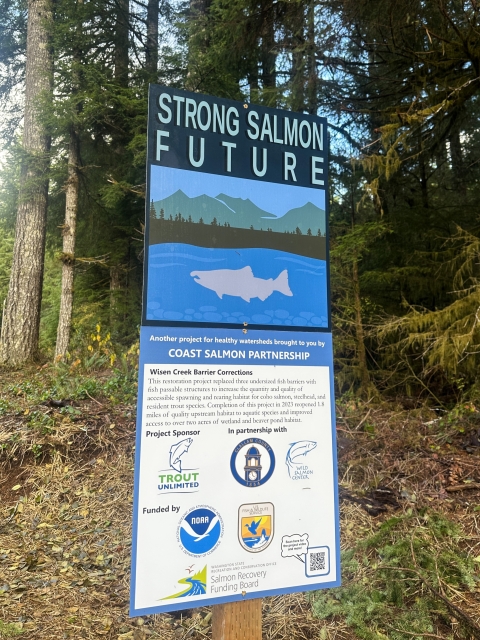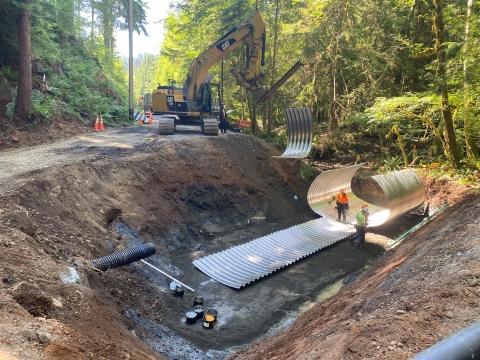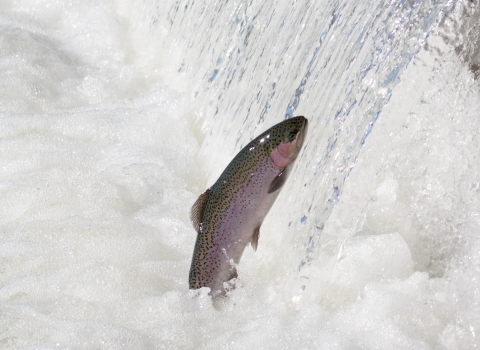By Jan Peterson, for the U.S. Fish and Wildlife Service
Sometimes, clearing a barrier to fish passage fish passage
Fish passage is the ability of fish or other aquatic species to move freely throughout their life to find food, reproduce, and complete their natural migration cycles. Millions of barriers to fish passage across the country are fragmenting habitat and leading to species declines. The U.S. Fish and Wildlife Service's National Fish Passage Program is working to reconnect watersheds to benefit both wildlife and people.
Learn more about fish passage is a straight-forward issue: Remove a poorly designed or crumbling culvert, install a smartly designed new one, and many miles of access to cold, clear water are opened.
On Washington’s Olympic Peninsula, it’s not that simple.
At its peak stands Mount Olympus at almost 8,000 feet. Its glaciers and snow fields feed the streams that flow into the Pacific Ocean, from which many species of fish return to spawn in the cold fresh-water streams. Among them are the Endangered Species Act-listed bull trout and other at-risk species such as coho and Chinook salmon.
But along its slopes are countless roads crisscrossing the mountainous terrain, created by humans for the timber industry and for other reasons. Each is littered with culverts and other fish-passage obstacles. The Wild Salmon Center says there are more than 4,000 documented barriers on the peninsula alone, with more than 20,000 salmon barriers statewide.
Ben Cross, project leader at the U.S. Fish and Wildlife Service’s Western Washington Fish and Wildlife Conservation Office, says Jefferson and Clallam counties had a great many conservation needs, but they are in underfunded rural areas. “There are not many folks who live out there,” he says, “but there is a really high-value cold water habitat there that would continue into the future.”
“These are the last strongholds of these species that we need to protect, and we need to open these streams so the species remain more resilient to the future,” Cross says. “The cultural importance of these species to the Tribes and the people who have been living in this area since time immemorial is immense. These areas do cover traditional lands and traditional fishing areas of several Tribes,” Cross says.
Several groups came together in 2017 to identify the extent of the fish-passage problem and to find solutions that would preserve those cold water refuges – and the fish that spawn there – well into the future. They formed the Coldwater Connection Campaign, a collective of governmental and non-governmental organizations that share the common goal of opening 125 miles of habitat over the next decade.
Miranda Plumb was U.S. Fish and Wildlife Service’s National Fish Passage Program coordinator for Western Washington at the time. Now in ecosystem planning with the U.S. Forest Service, Plumb says the NFPP provided funding to the Washington Coast Salmon Partnership to get the campaign off the ground. The nonprofit group also partners with the Wild Salmon Center, Trout Unlimited, the Hoh Tribe, Quileute Tribe, Makah Tribe, Quinault Indian Nation and state and federal agencies.
In order to understand the scope of the problem, Luke Kelly, Western Washington Program Director at Trout Unlimited, and others took off on foot to walk every county road on the west side of the Olympic Peninsula in the two counties (over 650 culverts surveyed). “We were interested in the fish culverts but also agreed to do a rapid assessment on every culvert. If it had fish-use potential, we would do a more formal survey.”
With landowner permission, the team also walked streams up and down from the barriers, discovering a host of problems they didn’t even know about.
“It is fun to see the landscape and find something not on the map, like a derelict culvert that was once on a road, but the road is completely washed out and all that remains are big chunks of this very large culvert still impacting fish migration,” Kelly says.
“From the 1960s through the 1980s, hundreds of roads were built, cutting across mountain tops and there were thousands of culverts installed without much planning for fish migration,” he says. “Trying to wrap your head around that is tricky.”
The Coldwater Connection Campaign designed a database to prioritize the culverts and the problems they posed.
“We basically found 634 culverts associated with these county roads, but most were smaller drainage and not associated with aquatic species concerns. Eighty-one were associated with anadromous fish distribution. We confirmed 58 were a barrier to fish migration and 18 more needed additional surveys,” says Cross.
At the very top of the list were seven projects that showed the potential for greatest habitat gains and addressed species needs. Three of the priority projects were funded in part with National Fish Passage Project funding.
By the time the Bipartisan Infrastructure Law Bipartisan Infrastructure Law
The Bipartisan Infrastructure Law (BIL) is a once-in-a-generation investment in the nation’s infrastructure and economic competitiveness. We were directly appropriated $455 million over five years in BIL funds for programs related to the President’s America the Beautiful initiative.
Learn more about Bipartisan Infrastructure Law was signed into law in 2021, campaign partners had already identified the barriers and were able to move swiftly to apply for funding to remove them. Among the completed projects are Wisen, Anton and Cedar creeks.
“I think our familiarity with our partners really helped us and them get these projects funded through that first round of BIL funding,” Cross says.
Several projects have now been completed, thanks to the efforts of Coldwater Connection Campaign partners, BIL money and other funding partners.
Over at the Wild Salmon Center, Betsy Krier, fish habitat specialist, and Jess Helsley, director of watershed restoration, say they are thrilled the Bipartisan Infrastructure Law money arrived when it did.
“Transportation infrastructure isn’t cheap,” Helsley says. “We try to have myriad projects in the pipeline. BIL passed and we’ve been able to press forward.”
Helsley says these projects have a huge impact not only on the fish but also the people who live in the region and those who are deeply connected to the fish.
“Tribes in the Pacific Northwest are connected to salmon in ways I don’t think any of the rest of us will ever understand,” Helsley says.
And there are massive economic impacts. “For every million dollars of restoration funding that goes into a watershed, a lot of it stays in the watershed where the project occurs. Salmon means business for the Washington coast. We have some of the highest unemployment rates in Washington state. We hire local businesses and, when we can, hire local businesses that support Tribal families,” Helsley says.
Krier says the timing of funding was none too soon.
“We are running out of time to make a big impact in these fish populations, but we know that the Washington coast is the right place to be investing these funds.”
Our public lands, like our roads and bridges, require strategic investments and management to protect the fish and wildlife that is so important to the American public. The Bipartisan Infrastructure Law has committed $455 million to the U.S. Fish and Wildlife Service over five years to support our natural infrastructure and protect these valuable resources.









